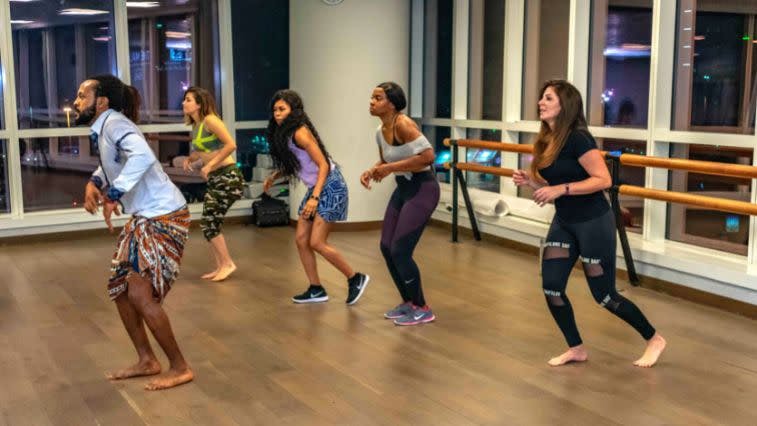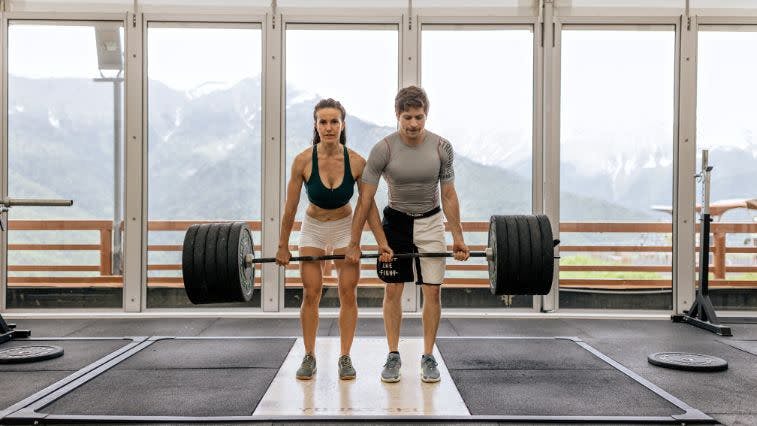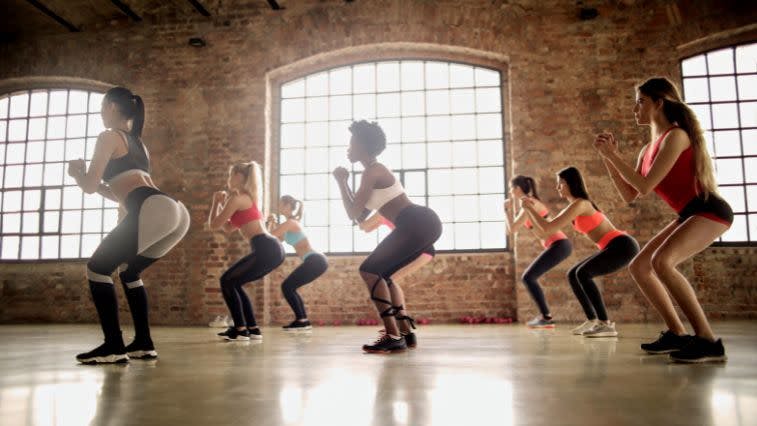What Works Best for Weight Loss: Cardio or Weights?
Our content strives to support, inform, and motivate you to meet your health goals. We want to be your trusted source of expert- and science-backed info dispensed in simple, actionable ways. Read our Editorial Guidelines.
Fitness gurus and airchair experts can wax on (and on and on!) about whether cardio or weight lifting works better for weight loss, but the truth is that it all boils down to facts, figures, and real science.
So what does research say about this ongoing debate? And what other key factors come into play when your goal is to shed some fat? (Spoiler: there’s nuance!) We’ve gone down the rabbit hole to get to the bottom of the issue, and have some clear and actionable tips you can start using as soon as today.
The Great Debate: Cardio vs. Weights for Weight Loss
While you can technically lose weight by sticking to one over the other, the ideal approach is a combination of both cardio and strength training. We’ll dive into the specifics below, but this dual approach benefits your overall health and fat loss. “A combination of cardio and weight training will give you the best results when it comes to losing weight,” says Sara Haley, ACE-certified personal trainer. “Cardio exercise will burn the most calories and increase the health of your heart where lifting weights builds the most muscle and increases your metabolism.” This increase in metabolism Haley talks about is a boost in your resting metabolic rate (RMR) — that is how much energy you burn when you’re not physically active. You can increase your RMR even more with an intense weight lifting or heart-pounding aerobic effort. This effect is known as post-energy oxygen consumption (EPOC), which increases the amount of calories you burn in the 12 to 20 hours following an intense sweat session — be it high-intensity interval training or resistance training.
Doing both cardio and strength training also helps keep things interesting, notes Haley. You could just stick to cardio, but then you run the risk of growing, “bored in the process and missing out on a lot of great muscle tone,” and the other benefits of weight training (such as regenerating bone, reducing blood pressure, and improving insulin sensitivity). And you could just stick to strength training, but then you’re missing out on some of those intense calorie-burning sessions and improved heart, lung, and mental health benefits.
How Cardio Helps With Weight Loss & Health

Also referred to as aerobic exercise — and short for cardiovascular exercise — cardio is any physical activity that increases your heart rate and breathing, and maintains that elevation for the bulk of the workout.
Because your body is working in overdrive, cardio tends to burn more calories overall during the session compared to how many calories you’d burn during weight training. Cardio exercise is also tied to improved heart health, brain function, mood, sleep, and overall energy levels.
Moderately intense cardio reaches 50% to 70% of your maximum heart rate and intense or vigorous exercise reaches 70% to 85% of your maximum heart rate. To estimate your maximum heart rate, simply subtract your age from 220.
You can track your heart rate with a fitness tracking device, or you can stop and take your pulse (count the beats for 30 seconds, then multiply by two). If your body isn’t used to physical exercise, it’s best to start with moderate intensity and work your way to more vigorous exercise.
The Most Effective Type of Cardio for Weight Loss

Many forms of cardio exist, and the best approach is ultimately whichever one you get excited about.
“HIIT involves alternating short bursts of intense exercise with short periods of rest,” explains Krystal Quagliara, health and wellness coach, and founder of Krystalized Health Advisors. “In a study conducted in healthy men by the Journal of Strength and Conditioning Research, it was found that HIIT exercise can burn 25% to 30% more calories per session than regular sustained cardio or weight training [done for the same amount of time].”
This isn’t to say that other forms of cardio aren’t effective in leading to weight loss. Research conducted at Cal State Fullerton showed that when study participants performed moderate-intensity cardio for 30 minutes and HIIT for 15 minutes, the moderate-intensity cardio group burned more calories during the workout and slightly more calories after the workout.
To put things into perspective, if you’re short on time and have the fitness and ability to go hard during a short HIIT session, you’ll get a good (calorie) burn for the time investment. But, keep in mind that the high-impact, high-intensity nature of HIIT means you shouldn’t do it every day, but rather a couple of times a week at most to give your body plenty of time to recover. Also, if you’re new to exercise, moderate-intensity cardio may be more your speed and it’ll give your joints, muscles, heart, and lungs time to adapt.
It’s best to ease yourself into higher-intensity exercise and pay attention to what your body is telling you.
How Weight Training Boosts Weight Loss
Rather than a focus on increased heart rate and breathing, weight lifting builds and tones muscle, improves muscular endurance, and increases bone density and joint strength. As such, it involves lifting free weights or kettlebells, utilizing weight lifting machinery, using resistance bands, and leveraging your own body to increase strength (e.g. push-ups and pull-ups).
While weight training tends to burn fewer calories during an active session compared to cardio, research shows that it increases your metabolic rate, which ultimately helps you burn more calories while at rest.
“The more lean muscle mass you have on your body, the more calories you’ll burn at rest,” says Quagliara. “This is referred to as your resting metabolic rate. RMR increases as lean muscle increases and fat mass decreases.”
Like cardio, strength training has its own set of good-for-you benefits, including increasing bone density, improved balance, chronic pain management (e.g. back pain and joint pain from arthritis), better posture and movement patterns, and the ability and independence to do everyday tasks in aging adults. The Centers for Disease Control and Prevention (CDC) recommends allocating two or more days per week to strength training exercises, making sure to give each of your major muscle groups a good run for their money (legs, hips, back, abdomen, chest, shoulders, and arms).
The Best Type of Strength Training for Weight Loss

Research is constantly evolving, but scientists have found that the most effective approach to losing weight through strength training is full-body workouts with compound exercises — aka movements that engage multiple muscle groups at once. Some excellent examples include squats, deadlifts, dips, planks, push-ups, pull-ups, and lunges.
Strength training performed twice a week by 164 overweight and obese premenopausal women showed that strength training can help prevent the annual body fat increases, especially in the tummy, that many women experience as they age.
Pairing increased training intensity with shorter rest times between sets is a key factor in trying to achieve weight loss from strength training. The American Council on Exercise says that when rest time is decreased, the body experiences notable metabolic stress, which triggers both fat burn and muscle gain. There’s also a correlation between shorter rest times and EPOC. This style of increased intensity and shorter rest intervals can cause too much stress long term, so cycle this training strategy with lower intensity and higher volume to avoid burnout. If you’re not sure how to do this, sign up for a free consultation with one of Kickoff’s certified personal trainers to get a customized strength training program.
Bottom Line on Cardio or Weights for Weight Loss
Aim for at least 150 to 300 minutes per week of moderate cardio (or 75+ minutes of vigorous cardio), along with two or more sessions of moderate- to high-intensity muscle strengthening activity. If you want to do both in one day, note that there’s been some interesting research regarding whether you should do cardio before or after weights for fat loss. A small study discovered that starting with weight training burned more fat during the cardio workout versus starting with cardio. Just don’t rest too long between strength training and cardio — the study group with the shortest rest between strength and cardio burned the most fat. Keep in mind that:“Men and women carry weight differently, therefore initial fat loss may show up in certain areas faster for men versus women,” notes Quagliara. “A study in the American Journal for Men’s Health has shown that in the short term, men lose weight more rapidly than women. But, studies concluded that over a longer period of time when regimens were maintained by both women and men, fat loss rates had evened out.”
Nutrition: A Key Pillar of Weight Loss
While strength training and cardio play an important role in a healthy, balanced lifestyle, it’s not the sole component of losing weight or maintaining good physical health. The real shining trifecta occurs when you loop in good nutrition, notes Quagliara.
For some real scientific oomph to back this up, we can look at a research review published in The Journal of the Academy of Nutrition and Dietetics. It looked at data from more than 1,000 people; some groups focused solely on exercise while others focused solely on diet. Those who prioritized both were the most successful in losing weight and keeping it off when researchers checked back in around the one-year mark.
“Nutrition also affects metabolic health including blood sugar, insulin resistance, cholesterol, and sleep — all of which are factors in reducing the risk for type 2 diabetes and heart disease,” Quagliara adds.
So what counts as good nutrition? The key is to focus on eating a balance of high-quality, whole foods that nourish your body and help keep you satisfied and fueled. Get in tune with your hunger and satisfaction signals, make sure you’re drinking enough water, and try to better understand the triggers that may cause you to overeat.
When you’re eager to lose weight, be wary that you don’t overdo things. You can reach a place where you’re exercising too much and not allowing for enough (or any!) recovery. You can also flip the other way and gain weight when you exercise more because the extra activity could trigger cravings or hunger. Refuel as needed after a workout, but make sure it’s not turning into an excuse — or intense trigger — to eat everything in sight. Get a free consultation with a personal trainer who can design a balanced, customized exercise and nutrition plan to help you lose weight.